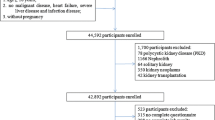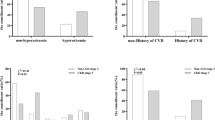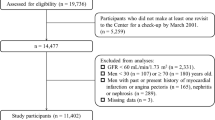Abstract
The renal outcome of solitary kidney remains controversial. We examined the longitudinal association of congenital or acquired solitary kidney with the development of chronic kidney disease (CKD). A cohort study was performed involving 271,171 Korean men and women free of CKD at baseline who underwent a health screening program and who were followed annually or biennially for an average of 5.4 years. Solitary kidney was determined based on ultrasonographic findings. CKD was defined as an estimated glomerular filtration rate of < 60 ml/min/1.73 m2 and/or the presence of proteinuria in two or more consecutive visits. During 1,472,519.6 person-years of follow-up, 2989 participants developed CKD (incidence rate: 2.0 per 1000 person-years). After adjustment for potential confounders, the aHR (95% CIs) for incident CKD comparing solitary kidney to the control was 3.26 (1.63–6.54). In analyses of cause-specific solitary kidney, aHR (95% CIs) for CKD comparing unilateral nephrectomy and congenital solitary kidney to the control were 6.18 (2.31–16.49) and 2.22 (0.83–5.92), respectively. The association between solitary kidney and CKD was stronger in men. Having a solitary kidney was independently associated with an increased risk of CKD development. Therefore, preventive strategies for reducing the risk of CKD are required in individuals with a solitary kidney.

Similar content being viewed by others
References
Jha V, Garcia-Garcia G, Iseki K, et al. Chronic kidney disease: global dimension and perspectives. Lancet (London, England). 2013;382(9888):260–72. https://doi.org/10.1016/S0140-6736(13)60687-X.
Mujais SK, Story K, Brouillette J, et al. Health-related quality of life in CKD Patients: correlates and evolution over time. Clin J Am Soci Nephrol CJASN. 2009;4(8):1293–301. https://doi.org/10.2215/CJN.05541008.
Brenner BM, Garcia DL, Anderson S. Glomeruli and blood pressure. Less of one, more the other? Am J Hypertens. 1988;1(4 Pt 1):335–47.
Brenner BM. Nephron adaptation to renal injury or ablation. Am J Physiol. 1985;249(3 Pt 2):F324–37. https://doi.org/10.1152/ajprenal.1985.249.3.F324.
Sanna-Cherchi S, Ravani P, Corbani V, et al. Renal outcome in patients with congenital anomalies of the kidney and urinary tract. Kidney Int. 2009;76(5):528–33. https://doi.org/10.1038/ki.2009.220.
Baudoin P, Provoost AP, Molenaar JC. Renal function up to 50 years after unilateral nephrectomy in childhood. Am J Kidney Dis. 1993;21(6):603–11.
Argueso LR, Ritchey ML, Boyle ET Jr, Milliner DS, Bergstralh EJ, Kramer SA. Prognosis of children with solitary kidney after unilateral nephrectomy. J Urol. 1992;148(2 Pt 2):747–51.
Argueso LR, Ritchey ML, Boyle ET Jr, Milliner DS, Bergstralh EJ, Kramer SA. Prognosis of patients with unilateral renal agenesis. Pediatric Nephrol (Berlin, Germany). 1992;6(5):412–6.
Wikstad I, Celsi G, Larsson L, Herin P, Aperia A. Kidney function in adults born with unilateral renal agenesis or nephrectomized in childhood. Pediatric Nephrol (Berlin, Germany). 1988;2(2):177–82.
Rugiu C, Oldrizzi L, Lupo A, et al. Clinical features of patients with solitary kidneys. Nephron. 1986;43(1):10–5.
El-Agroudy AE, Sabry AA, Wafa EW, et al. Long-term follow-up of living kidney donors: a longitudinal study. BJU Int. 2007;100(6):1351–5. https://doi.org/10.1111/j.1464-410X.2007.07054.x.
Goldfarb DA, Matin SF, Braun WE, et al. Renal outcome 25 years after donor nephrectomy. J Urol. 2001;166(6):2043–7.
Saran R, Marshall SM, Madsen R, Keavey P, Tapson JS. Long-term follow-up of kidney donors: a longitudinal study. Nephrol Dial Transplant. 1997;12(8):1615–21.
Najarian JS, Chavers BM, McHugh LE, Matas AJ. 20 years or more of follow-up of living kidney donors. Lancet (London, England). 1992;340(8823):807–10.
Fournier C, Pallet N, Cherqaoui Z, et al. Very long-term follow-up of living kidney donors. Transpl Int. 2012;25(4):385–90. https://doi.org/10.1111/j.1432-2277.2012.01439.x.
Narkun-Burgess DM, Nolan CR, Norman JE, Page WF, Miller PL, Meyer TW. Forty-five year follow-up after uninephrectomy. Kidney Int. 1993;43(5):1110–5.
Chang Y, Ryu S, Choi Y, et al. Metabolically healthy obesity and development of chronic kidney disease: a cohort study. Ann Intern Med. 2016;164(5):305–12. https://doi.org/10.7326/M15-1323.
Chang Y, Kim BK, Yun KE, et al. Metabolically-healthy obesity and coronary artery calcification. J Am Coll Cardiol. 2014;63(24):2679–86. https://doi.org/10.1016/j.jacc.2014.03.042.
Ryu S, Chang Y, Choi Y, et al. Age at menarche and non-alcoholic fatty liver disease. J Hepatol. 2015;62(5):1164–70. https://doi.org/10.1016/j.jhep.2014.11.041.
World Health Organization, Regional Office for the Western Pacific. The Asia-Pacific perspective: redefining obesity and its treatment. Sydney: Health Communications Australia; 2000.
Levey AS, Stevens LA, Schmid CH, et al. A new equation to estimate glomerular filtration rate. Ann Intern Med. 2009;150(9):604–12.
Levey AS, Coresh J, Greene T, et al. Expressing the Modification of Diet in Renal Disease Study equation for estimating glomerular filtration rate with standardized serum creatinine values. Clin Chem. 2007;53(4):766–72. https://doi.org/10.1373/clinchem.2006.077180.
Matsushita K, Mahmoodi BK, Woodward M, et al. Comparison of risk prediction using the CKD-EPI equation and the MDRD study equation for estimated glomerular filtration rate. JAMA. 2012;307(18):1941–51. https://doi.org/10.1001/jama.2012.3954.
Matthews DR, Hosker JP, Rudenski AS, Naylor BA, Treacher DF, Turner RC. Homeostasis model assessment: insulin resistance and beta-cell function from fasting plasma glucose and insulin concentrations in man. Diabetologia. 1985;28(7):412–9.
Royston P, Parmar MK. Flexible parametric proportional-hazards and proportional-odds models for censored survival data, with application to prognostic modelling and estimation of treatment effects. Stat Med. 2002;21(15):2175–97. https://doi.org/10.1002/sim.1203.
Sinn DH, Kang D, Chang Y, et al. Non-alcoholic fatty liver disease and progression of coronary artery calcium score: a retrospective cohort study. Gut. 2017;66(2):323–9. https://doi.org/10.1136/gutjnl-2016-311854.
Hayslett JP. Functional adaptation to reduction in renal mass. Physiol Rev. 1979;59(1):137–64. https://doi.org/10.1152/physrev.1979.59.1.137.
Dicker SE, Shirley DG. Mechanism of compensatory renal hypertrophy. J Physiol. 1971;219(3):507–23.
Brenner BM, Mackenzie HS. Nephron mass as a risk factor for progression of renal disease. Kidney Int Suppl. 1997;63:S124–7.
Seeman T, Patzer L, John U, et al. Blood pressure, renal function, and proteinuria in children with unilateral renal agenesis. Kidney Blood Press Res. 2006;29(4):210–5. https://doi.org/10.1159/000095735.
Higashihara E, Horie S, Takeuchi T, Nutahara K, Aso Y. Long-term consequence of nephrectomy. J Urol. 1990;143(2):239–43.
Smith S, Laprad P, Grantham J. Long-term effect of uninephrectomy on serum creatinine concentration and arterial blood pressure. Am J Kidney Dis. 1985;6(3):143–8.
Robitaille P, Mongeau JG, Lortie L, Sinnassamy P. Long-term follow-up of patients who underwent unilateral nephrectomy in childhood. Lancet (London, England). 1985;1(8441):1297–9.
Maggiore U, Budde K, Heemann U, et al. Long-term risks of kidney living donation: review and position paper by the ERA-EDTA DESCARTES working group. Nephrol Dial Transplant. 2017;32(2):216–23. https://doi.org/10.1093/ndt/gfw429.
Ibrahim HN, Foley R, Tan L, et al. Long-term consequences of kidney donation. New Engl J Med. 2009;360(5):459–69. https://doi.org/10.1056/NEJMoa0804883.
Muzaale AD, Massie AB, Wang MC, et al. Risk of end-stage renal disease following live kidney donation. JAMA. 2014;311(6):579–86. https://doi.org/10.1001/jama.2013.285141.
Mjoen G, Hallan S, Hartmann A, et al. Long-term risks for kidney donors. Kidney Int. 2014;86(1):162–7. https://doi.org/10.1038/ki.2013.460.
Chung BH, Jung MH, Bae SH, et al. Changing donor source pattern for kidney transplantation over 40 years: a single-center experience. Korean J Internal Med. 2010;25(3):288–93. https://doi.org/10.3904/kjim.2010.25.3.288.
Freedman BI, Volkova NV, Satko SG, et al. Population-based screening for family history of end-stage renal disease among incident dialysis patients. Am J Nephrol. 2005;25(6):529–35. https://doi.org/10.1159/000088491.
VanderWeele TJ, Ding P. Sensitivity analysis in observational research: introducing the e-value. Ann Intern Med. 2017;167(4):268–74. https://doi.org/10.7326/m16-2607.
Abou Jaoude P, Dubourg L, Bacchetta J, Berthiller J, Ranchin B, Cochat P. Congenital versus acquired solitary kidney: is the difference relevant? Nephrol Dial Transplant. 2011;26(7):2188–94. https://doi.org/10.1093/ndt/gfq659.
Cherikh WS, Young CJ, Kramer BF, Taranto SE, Randall HB, Fan PY. Ethnic and gender related differences in the risk of end-stage renal disease after living kidney donation. Am J Transplant. 2011;11(8):1650–5. https://doi.org/10.1111/j.1600-6143.2011.03609.x.
Silbiger S, Neugarten J. Gender and human chronic renal disease. Gender Med. 2008;5(Suppl A):S3–10. https://doi.org/10.1016/j.genm.2008.03.002.
Neugarten J, Acharya A, Silbiger SR. Effect of gender on the progression of nondiabetic renal disease: a meta-analysis. J Am Soc Nephrol JASN. 2000;11(2):319–29.
Iseki K. Gender differences in chronic kidney disease. Kidney Int. 2008;74(4):415–7. https://doi.org/10.1038/ki.2008.261.
Gretz N, Zeier M, Geberth S, Strauch M, Ritz E. Is gender a determinant for evolution of renal failure? A study in autosomal dominant polycystic kidney disease. Am J Kidney Dis. 1989;14(3):178–83.
Hopper J Jr, Trew PA, Biava CG. Membranous nephropathy: its relative benignity in women. Nephron. 1981;29(1–2):18–24.
Zeier M, Gafter U, Ritz E. Renal function and renal disease in males or females–vive la petite difference. Nephrol Dial Transpl. 1998;13(9):2195–8.
Yanes LL, Sartori-Valinotti JC, Reckelhoff JF. Sex steroids and renal disease: lessons from animal studies. Hypertension. 2008;51(4):976–81. https://doi.org/10.1161/HYPERTENSIONAHA.107.105767.
Author information
Authors and Affiliations
Contributions
Research idea and study design: SK, YC, SR; data analysis/interpretation: SK, YC, YRL, YC, KEY, HSJ; statistical analysis: SR; supervision or mentorship: SR, YRL, YYH, KBL, KJJ, HS. Each author contributed important intellectual content during manuscript drafting or revision and accepts accountability for the overall work by ensuring that questions pertaining to the accuracy or integrity of any portion of the work are appropriately investigated and resolved. SR and YC take responsibility that this study has been reported honestly, accurately, and transparently; that no important aspects of the study have been omitted, and that any discrepancies from the study as planned have been explained.
Corresponding authors
Ethics declarations
Conflict of interest
The authors have no conflicts of interest to disclose.
Additional information
Publisher's Note
Springer Nature remains neutral with regard to jurisdictional claims in published maps and institutional affiliations.
Electronic supplementary material
Below is the link to the electronic supplementary material.
Rights and permissions
About this article
Cite this article
Kim, S., Chang, Y., Lee, Y.R. et al. Solitary kidney and risk of chronic kidney disease. Eur J Epidemiol 34, 879–888 (2019). https://doi.org/10.1007/s10654-019-00520-7
Received:
Accepted:
Published:
Issue Date:
DOI: https://doi.org/10.1007/s10654-019-00520-7




